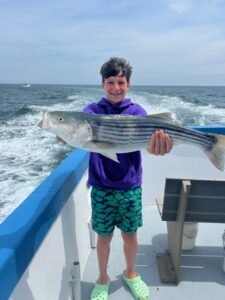The summer of 2024 will be remembered on the waterfront as the summer of wind. Apart from a few windless days here and there, we have been pummeled day in and day out by relentless winds that have hampered our efforts to get out there and fish or whale watch. We’ve done a lot of fishing in miserable wind, and too often we haven’t been able to leave the dock at all.
When it’s reasonable and we can get out, though, the striped bass fishing is pretty good. The best area of late is the same as it has been for most of the season, that is, from Race Point to Peaked Hill. The bass have really settled into that area, which is chock-full of sand eels. Every bass we catch has a stomach full of sand eels and only sand eels.

Wire line trollers are enjoying the most success, as the fish are spread out and not bunching up in big tight schools. Trolling is most effective in those situations, plus the fish are staying hunkered down on the bottom and not coming to the surface much. That would explain the lack of success people are having with swimming plugs and poppers. Capt. Russ of the Liza Z has been coming in with consistently outstanding catches of fish exclusively caught on wire line umbrella rigs.
Bluefish are still nowhere to be found. We’re not seeing them in the bay or on the ocean side of the Outer Cape. Sure, we’re catching a few here and there, but the big charge of bluefish we usually see around here by now has yet to arrive and settle in. We still have time to get them in here, but the high summer window is slowing starting to close. Likewise, I haven’t seen or heard of many giant tuna coming into port this past week. Maine continues to be the tuna hot spot so far.
I’m probably one of the few commercial fishermen out here who used to teach high school science — I’m the type who can’t help tracking climate change and responses to it. But there is a proposed experimental project coming out of the Woods Hole Oceanographic Institution that is leaving me scratching my head. They’re looking to shift the alkalinity of the ocean as a possible way to reduce the negative effects of climate change.
To do that, they want to release 6,600 gallons of sodium hydroxide into the ocean about 10 miles south of Martha’s Vineyard, according to a July 11 report on WBUR in Boston, a National Public Radio outlet. I’m not the only one who is concerned — the idea is already getting pushback from environmentalists and the commercial fishing industry.
The concept is called OAE, ocean alkalinity enhancement, and the idea is that it could reverse the ocean acidification that we have seen is linked to hypoxia (reduced oxygen levels in the water) and seems to be a threat to shellfish. It would also, they hope, increase the water’s ability to absorb excess carbon dioxide from the air.
I’m told the Indie’s science reporter is looking into this. I’m looking forward to reading what he finds out, but meanwhile, rather than rant — because that’s my instinct here — I have some questions for him. First, it seems to me we’ve been trying to manipulate Earth’s core systems for centuries, and it isn’t going that well: to date we have not been able to fool Mother Nature. And sodium hydroxide is a strong base, so it’s highly caustic. We need to know what the scientists plan to do about preventing harm to fish and mammals.



